- Congratulations on winning the French Embassy Prize for Young Choreographer of the Yokohama Dance Collection EX2012 for your work Hetero created in collaboration with Kaori Seki. It is a composition for a male and female duo in which most of the movement is done symmetrically in unison. The movement is consistently slow throughout the piece and I was surprised by how meticulous the composition was. I felt it was an outstanding work in terms of its serious approach to bodily movement. I would like to begin by asking you about this piece Hetero. How did you divide the choreographing process with Ms. Seki?
- With this piece we began by talking together about all aspects of the choreography and the staging and then we began the creating choreographing the movements as we moved. This creative process was going on during a period of about one month just before and after last year’s 3.11 Great East Japan Earthquake and Tsunami. For the piece’s debut in 2011, I danced the male part, but this time [Yokohama Dance Collection EX2012] we had Daiji Meguro perform the male part.
- Despite being a dance, there are few places in this piece where the dancers are actually “dancing” in the usual sense of the word. What made you want to create such a piece? Also, the title Hetero is a prefix that means other or different. And, from this title we can’t help but get associations with the word heterosexual, implying homosexuality. We also get associations with male and female differences and male and female sexuality and love.
-
Well, it is true that hetero has numerous meanings or associations, but I was attracted primarily to its meaning of “different.”
To begin with, Ms. Seki and I are active in an area that is close to each other, and we have a lot in common in terms of our way of thinking and the creative language we use, but our taste in works is different. In the studio, our creative process began with the question of how to work that difference in a work and by examining our separate ideas about “femininity” and “masculinity.”
At first we were thinking of a choreographic direction involving an interchange between my ideas of femininity and Seki’s ideas of masculinity, but as the work in the studio proceeded we realized that we could see “difference” more clearly in the parts that conflicting elements that stuck out when we were approaching a unified phrase of movement in the creative process. So, from that point we began a process of finding our differences in things like the way we stood or the way we moved when we were trying to express the same thing in the choreography. - Despite the meaning of the title Hetero, at first the piece seems to give an impression that is unisexual, doesn’t it? For one thing the color and shape of the costumes for the male and female dancers were the same. In that sense, you appear to have created a condition where feminine and masculine differences in costume, movement and [facial] expression are eliminated as much as possible so that the focus became purely on harmonizing the physical movement. Then, the “differences” seeped out naturally from that homogenized harmony and unison. As with the first performance, didn’t you have the desire to dance the male part this time as well?
- If I had danced it, I believe I wouldn’t have had the chance to study the essence of the work and why we did the things we did with the lighting and the staging. I believe that the opportunity to view the work objectively [by not dancing in it] helped give us insights to strengthen the work [for the Yokohama performance].
- I would like to go back now and ask what led you to first became involved in dance.
-
I began to dance seriously after entering university, around the age of 19. In high school I was in the school’s drama club and I entered Tamagawa University with the intention of studying to be an actor. From the second term, however, when were started doing serious stage work for performance, I lost my confidence and drive [grimaces]. I would choke up on stage and not be able to deliver my lines well. There were other classes in traditional Japanese dance (Nihon buyo) and rhythmic and I found that I fell freer in forms of expression like those that didn’t depend on words. I felt that I could express myself better in dance than in theater, so I became more interested in dance.
The first place I went to study was the studio of the Butoh artist Kazuo Ohno. For about three months I received instruction from [Kazuo Ohno’s son] Yoshito Ohno, although Kazuo Ohno was still healthy and active at the time. The following year I participated in the Mujinjuku workshop of the Dairakudakan company for about three months. I also took classes in traditional Japanese dance outside of my university classes for about two years. I hadn’t been a dancer until that time, but I had always liked being physically active. I had tried my hand at a number of sports, from little league baseball and swimming to volleyball in middle school and judo in high school. - Watching your solo dance performances, I felt that your strength as a dancer lies in the fact that your dance is not rooted either in modern dance or Butoh, and it contains some of the unique physical aspects that come from your training in traditional Japanese dance, doesn’t it? Why did you choose to study at the Kazuo Ohno studio first?
- I had seen a feature on Japan’s underground arts movements in the magazine Taiyo and I read its section on the Butoh of Ohno, Hijikata and Dairakudakan, which gave me an admiration for those artists of that era. Also, I wanted to see what would happen it I tried something I would not normally do.
- In one sense, aren’t the workshops of Kazuo Ono and Dairakudakan quite opposite in orientation. Ohno has a tendency to place most importance on the individual’s image and tries to develop things from that in order to achieve natural body movement. On the other hand, Dairakudakan uses its own terminology such as Furichu (kind of choreographing) and Chutai (mold body) in an approach based the pursuit of certain forms of movement through solid training and practice. Which of the two suited you better?
- I feel that it was very good that I got an experience of Ohno-san’s method of “body embodying image” at that point in my career when I was just starting out in dance. Because my body was not shaped yet as a dancer, learning that method of using images to expand your physical vocabulary brought greater scope to the things I wanted to do. That interest in the body and spirit of challenge (to create new vocabulary) continues for me to this day, and in that sense I think there is also the influence of the way of ancient Japanese martial arts.
- Another very interesting aspect of your career until now is that after that initial training you participated as a dancer in a great variety of works by a highly varied group of choreographers. Which works did you participate in first?
-
The first work I performed in was Coffee by
Mikuni Yanaihara and her company Nibroll. In my university there was a fellow student named Tatsuya Kusuhara who had begun dance before me, and when I asked him for advice, he told me about contemporary dance and said that I should go and watch performances of it. In the space of about two months after that I saw about 30 different performances, and I went to workshops as well. It was when I was participating in a Robyn Orlin workshop that Yanaihara-san spoke to me and had me dance in her work. That was at the time just before I graduated from university.
The creative process for a work at Nibroll was completely different from anything I had experienced up to that point and all the other dancers around me had impressive career credentials, so I decided that I just had to try hard and do the best I could. Around the same time, Kusuhara-san had started a group called “APE” and I participated in their productions too. It was difficult balancing my time and energies between Nibroll with their overseas performance tours and APE, which was a group of young people just out of university. That caused me to do a lot of thinking. - At the time, Coffee was one of the representative works on the Japanese contemporary dance scene, I believe. After that you also participated in productions by Kim Itoh’s companies. He is one who tore down the boundary between Butoh and contemporary dance and was an artist who truly led the Japanese contemporary dance world for about a decade from the mid-1990s.
-
I began performing in Itoh-san’s productions at a time when he was doing large-scale works for 30 or 40 dancers like the 2003 works Kaidan Shugi (Stair-ism) and Gekijo Yuen (Theater Amusement). After that I also performed in his work Kabe no Hana, which was performed in a party-like atmosphere, and the Itoh Kim + The Glorious Future company’s last work Mirai no Shirushi.
Kim Itoh is an artist I admire very much. When I saw his works Dead and Alive—Body on the Borderline and Dakishimetai (I Want to Hold You) performed at the Setagaya Public Theatre, I thought, “This is the pinnacle of contemporary dance!” And I thought that if I could enter his company it would be the best place to be a dancer. At the time I still thought of myself as a dancer [rather than a choreographer]. - Kim Itoh’s master was the Butoh artist Anzu Furukawa. The fact that you have performed in Kim Itoh’s works and studied at the Kazuo Ohno studio means that your relationship with Butoh is by no means a superficial one, doesn’t it? Didn’t you ever think that you wanted to specialize in Butoh?
- No, I never did. In fact I presented one of my own compositions at my graduation performance from Mujinjuku, but I was told at the time, “The dance you want to do is different from Dairakudakan’s, isn’t it?” And I had already become aware of that fact to some degree myself. I couldn’t see myself doing Butoh forever.
- After that you performed in the works of Un Yamada and finally the works of Ko Murobushi, didn’t you?
- Yes, I performed in two-work productions of Un Yamada’s W.i.f.e and One piece and then ges and Document. I first met Murobushi-san when they were auditioning dancers for the Asian tour of “Odori ni iku-ze!” in the summer of 2007 and I was accepted. At that time, I was getting one-on-one instruction in dancing from Daiji Meguro and Yukio Suzuki, and it wasn’t until I went to the Jacobs Pillow Festival as a dancer in the performances of DEAD1 in 2008 that I received serious instruction from Murobushi-san for the first time.
- I think you could have chosen to be a dancer affiliated with one of the companies full-time, but instead you went on to become a choreographer. Why was that?
-
Around 2005, I got together with about 30 fellow artists from Itoh Kim + The Glorious Future to rent a venue to do a two-day performance of five or six works. Until that time I had thought of myself strictly as a dancer. I had the feeling that everyone expected a dancer to begin choreographing works near the end of their dancing career, but I rebelled against that preconception. I though, “Why isn’t being a dancer enough? Why do we have to become choreographers?” When I was invited to join in that project, I accepted lightheartedly because I had no idea that I would end up creating works someday. So, together with Ayaka Azechi, who in now in Germany, I choreographed a work for the first time, titled Smoke.
It turned out to be unexpectedly successful, so I began to get the idea that I might choreograph just one more. Then the dance critic Takao Norikoshi recommended me for “Dance ga Mitai” series of works by critic-recommended choreographers, and I ended up doing the duo piece Mint and the solo piece double.
In 2007, I got together Seki-san and several other artists of our same generation to form the group Mure to do our own dance performances. At the same time, I was doing performances of my own solo pieces and participating as a dancer in Murobushi-san’s productions, so it was a very confused time. In 2008, I was chosen as the first recipient of the “Saka-agari Scholarship” jointly sponsored by Yokohama’s Steep Slope Studio, ST Spot and Noge Challet, which led me to begin choreographing new works on a full-time basis. - Once you began working on choreographing your own works seriously, did you find the influence of any one the choreographers you had worked with until then?
-
My first work definitely had a strong Nibroll influence, or perhaps I should say I used their working method as a model. I have great respect for
Kim-san and Un-san as artists of the generation before me and I learned a lot from the way they approach dance. However, I guess I would have to say that the biggest influence on my physical vocabulary and the way I approach a work has come from Murobushi-san.
Murobushi is a person who is very sincerely cautious about how a body is placed on the stage, so working with him made me constantly think about the meaning and form of a physical presence on the stage. While we were on tour I had opportunities to talk with Yukio Suzuki , and he said that whenever he is on the stage in one of Murobushi’s works he had to constantly be thinking about what he should be doing there. Because Murobushi was constantly telling the dancers things like, “You don’t need to dance at that point,” or “Why were you doing what you just did,” or “Isn’t there such a thing as dance where you don’t “dance”? I agreed with Suzuki completely. - It is true that in your works you don’t easily let out the energy that is directed inward in the body. Rather, I get the impression that you concentrate it inward while creating the overall movement of the piece. I think that was especially true in your works like UNTITLED (ST Spot/2010), where you worked with the musician Yoshio Ohtani for the first time creating a relationship between sound and the body. It was a very powerful work. In the work Sabi that you did last year in the entrance hall of the Setagaya Museum of Art, I felt that you not only concentrated consciousness inward within the body but also focused it outward to create and interactive effect with the walls, the floor and the air in between. That created a larger sense of the relationship with the space and time elements.
-
The offer to do a work there at the museum came at a very good time for me. Until then I had only been thinking about my own body, but that opportunity allowed me to create a work that focus on what I could do with this body and how I could change the structure of it in order to do what I intended. It was a good stimulus for me to receive that offer with the question of what I could do in that [entrance hall] space. I spent a good amount of time talking with the originator of the project, Ms. Miki Tsukada of the Setagaya Museum of Art, about the structure and materials used in that architectural space and what kind of people usually visited there and what roles the space performed.
I originally had no particular images of working in a space outside a theater, but through thought and discussions with the lighting specialist Ayumi Kito, the sound specialist Yuji Tsutsumida and the planner, I realized how much I was affected by an environment. I am interested not in skillfully making use of a space but in seeing what will happen when I use my body as a “medium” to enter into a space. It may be similar to what happened with Hetero, but I want to create works in which I was able to reflect in my body the things that invariably seep out when I place myself in a given space.
In the end, my real interest is in the body. Doing that work in the museum only broadened and deepened that interest. - The body cannot exist separate of its environment, it always exists within a space, so I believe that questioning how the state of the body differs in different environments is very important. In that sense, I felt that the solo work Zokibayashi (Grove of mixed trees) that you presented at the Asahi Art Square in 2011 was a summing up of the things you are dealing with artistically at present.
- As I was working on Zokibayashi it was as if I were attempting to work through once again the things I had discovered about the body in UNTITLED and the things I had discovered dealing with the space at the Setagaya Museum of Art. This work was actually a re-creation of part of UNTITLED in collaboration with the musician Ohtani-san, but it came out so different in form that I presented it as a new work.
- What was involved in the creative process?
-
What I am doing with Ohtani-san is exploring the “relationship between sound and the body.” I have always had a strong interest in the body, but with Sabi I wanted to re-examine what I really wanted to do with the body and what I was trying to do.
Basically, I don’t create works that connect dance to story narrative or people’s emotions. But physicality alone cannot make a meaningful work [of dance]. That truth led me to the idea that connecting music to a space and my body could create a form of “landscape.” I decided that I wanted to try and see what kind of “landscape” would appear in a space that had just the body and music and lighting and acoustics, without any narrative or my own emotions to define it.
The creative process when I work with Ohtani-san begins with a concept that I have come up with. Then I meet with him several times to discuss it. Ohtani-san is not only a musician but a critic as well, so I have him think over my concept with me. With Zokibayashi, I had brought “landscape” forward as an initial key word and we discussed things like how a landscape could be created and what kind of relationship between the body and music could possible create it. For about a month after that I worked alone in the studio to create parts [of physical movement] that could be put together in a composition. At that point the work had no beginning or end, and was just working parts of the performance that I wanted to do. Then I showed them to Ohtani-san and he brought his music equipment into the studio for several days of working sessions. The creative process progressed in a style where we would investigate the reasons for both the sound and the movement and the resulting pluses and minuses of each. - It surprises me that your work Zokibayashi was followed by a work like Hetero. In Hetero the only sound environment involved is a few sections where the sound of breathing comes in and virtually nothing else to disturb the serene tempo of the dancers’ movement. The well-balanced movement of the two dancers continues in an atmosphere of positive tension with no elements of narrative or emotions, doesn’t it?
- There is a consistent theme running through my work. It is that when I move my body I am always thinking about the concept of chukan (space in between, middle points). That means I am always thinking about things like the space between the music and me or the middle point of my center of gravity. In Japan’s traditional martial arts [like judo] there is the concept of remaining fluid and not creating any “fulcrum points” in the body, but it is not that there is some type of movement that produces that effect but, rather, that through a very complex process you avoid creating a center [of gravity]. In my case I am intent on creating a body that keeps a space between that center, and when I am creating a work I don’t set clear forms in the choreography (because I want to maintain a space between the body and the choreographed form/movement). It may be more accurate to say, “there is no choreography as form,” but that sense Zokibayashi and Hetero are the same.
- What made you want to create that kind of “body that maintains space away from the center”?
-
I think it comes from my past personal experiences. One was an experience of hurting a friend very badly during my adolescence, after which I tried to be more rational and maintain a safer distance from my basic feelings. But there are times when there is a feeling that I just can’t control, and I take that as evidence that it must be my true feeling and unavoidable. When such a time comes in sports, I have experienced moments of using the body to a point beyond control.
Also, my generation often spoke in terms of individual or unique kyara (character/traits) and in more minor cases of ura-kyara (sub character). But, I never felt that kind of unique character [traits] in myself. I always felt that I was quite ordinary. I had no big story or incidents or accidents to speak of and no unique presence that could communicate easily to others. That made me come to think what would happen if I simply pursued that “ordinariness” without exaggerating or trying to stand out. I thought that trying not to reject things because they lack unique character but, rather, taking it all in might lead to something truly unique and even monstrous.
So, with that experience from my adolescence and what I learned from traditional martial arts about a type of body [movement] that creates no fulcrums, I believe that I came to pursue a state of body that maintains a space between itself. - When one speaks of “having no fulcrums,” I believe it can be understood on the level of physics applied to physical movement, or it can be understood on a metaphorical level. I think that in your case, with your creative approach that deliberately avoids presenting unique character or superficial attempts to look good and to approach the body straight on without affectation, it can be seen as “having no fulcrums” in a metaphorical sense, can’t it?
- Perhaps so. There are naturally some creators that are geniuses, but for someone like me who is not a genius, I am always thinking about how I can create forms of expression that hold their own. With regard to talent, or genius, in a way I have chosen to start from the assumption that I have no talent. Instead of longing for talent and hoping that I have some, I have chosen to pursue the things that I actually have interest in and can continue to dig into as deep as I can. At the same time, I also have the ideas that I would like to be able to become anything that I choose, and that becoming too fixed on one thing reduces the possibilities in my life, and that since I am nothing to begin with, I can perhaps become anything I want. Of course it takes great effort and rather than deciding too easily what I am, I want to take everything in first and then think about what I will be.
- You have done many solo and duo dance works, but don’t you also have interest in choreographing for groups of dancers?
-
I have the feeling that I would like to take on that challenge, but I also have the feeling that I want to take things cautiously and be sure of what I am doing first. I want to continue with my strong attachment to the body and continue to use my own body as the testing ground for what I do, and only now do I feel that I have become able to deal with spaces as well. In part, I’m not really sure if this stage is necessary or not, but I feel that with the piece Zokibayashi I have been able to reflect it in my choreography. Although the physical forms are not clearly defined in the choreography, I thought that this is perhaps a work that I could give to others to perform [from my choreography]. I also feel that the next step is to find out what happens when it is transferred to other bodies [than my own] to perform.
However, I want to proceed in a direction that puts as few restrictions on me as possible. I want to be able to enjoy whatever gets thrown my way and whatever it does to me. Just as doing only solo pieces can become a [confining] framework in itself, I feel that consistently doing performances in places like the museum or doing collaborations with overseas partners could become frameworks that confine me as well. I want to remain open and keep from falling into confining frameworks so that as many different things as possible will come my way. - Is there anything you want to convey through your dance or your creative activities to the younger generation of creators?
-
It is difficult to express, but I guess it would be to remain open and receptive to a variety of things but at the same time maintain a questioning mind. I always think—and this may sound like a contradiction—that when you believe deeply in something or feel that something is good, it will help broaden your creative possibilities if you can also bring to it a mind that can question and pose doubts. One may be happier if they are able to believe something with the mind, but I would like to see young creators retain a bit of question in their minds. That doesn’t mean stepping back and questioning something but, rather, diving into it without completely surrendering the ability to question and to peel back layers of falsity any time they might appear. I guess you could say that is how I am trying to be and I feel that seeing the works of creators like that, or talking to them, can bring discoveries of things that are strong and things that we can believe in. That is all that I think I would like to say to them.
When I see young creators who are seeking only purity without questions or doubt, I feel that being able to balance that energy with an equal energy in the opposing direction can bring greater richness to their creations.
Teita Iwabuchi
Creating landscapes with the body –
The explorations of Teita Iwabuchi
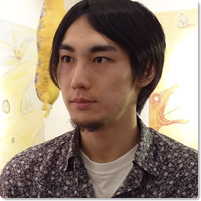
Teita Iwabuchi
Teita Iwabuchi in collaboration with Kaori Seki choreographed the work that drew the most attention out of the 140 entries from eight counties in Competition I (Dance Composition Division) of the 2012 Yokohama Dance Collection EX, a contest widely known as the gateway to success for progressive new contemporary dance artists in Japan. After studying theater and Japanese traditional dance at university, Iwabuchi participated as a dancer in productions by such leading groups in Japan’s contemporary dance scene since the 1990s as APE, Nibroll, Itoh Kim + The Glorious Future, Co. Yamada-Un and Ko & Edge.
[Interviewer: Tatsuro Ishii (dance critic)]
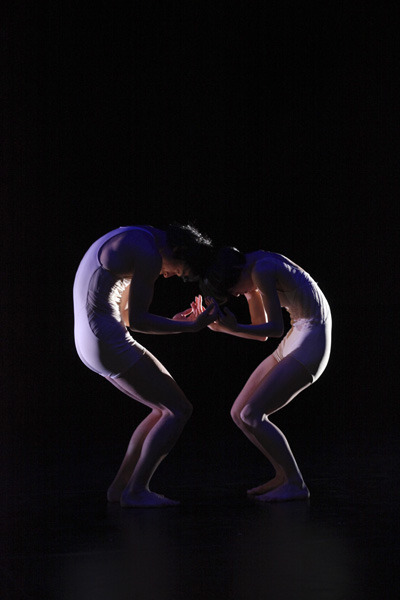
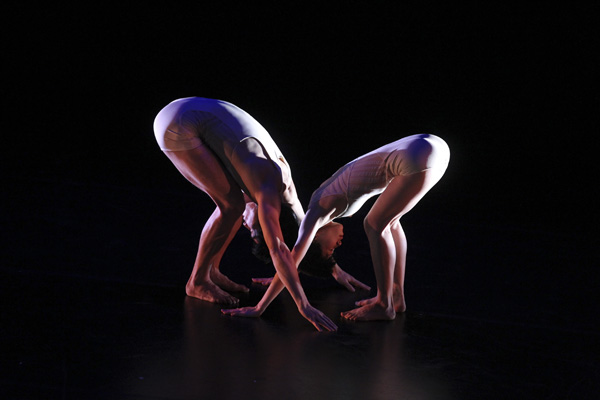
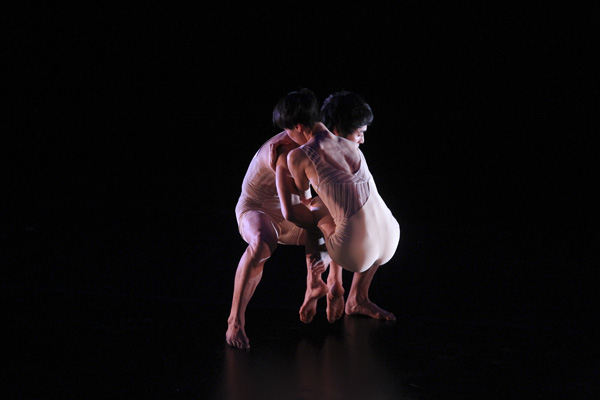
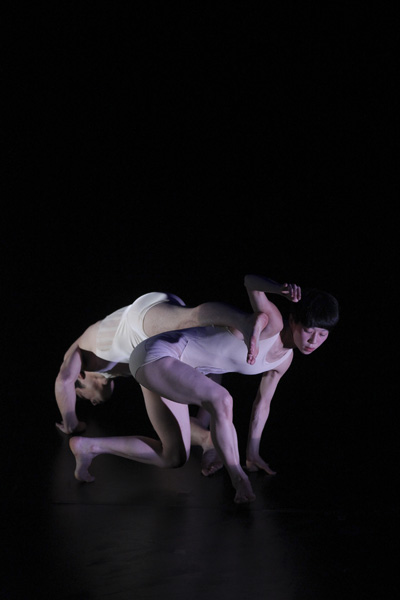
Hetero
(Performance in 2012 Yokohama Dance Collection EX, February 11, 2012 at Yokohama Red Brick Warehouse Number 1 3F Hall)
Choreographed by Teita Iwabuchi and Kaori seki
Performed by Daiji Meguro and Kaori Seki
*Premiered on April 21, 2011 at Sengawa Theater. Performed by Iwabuchi and Seki.
Related Tags

